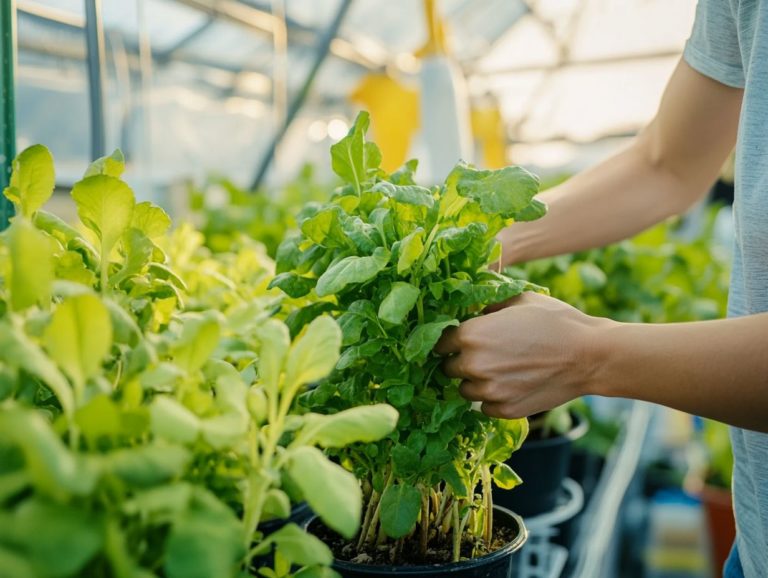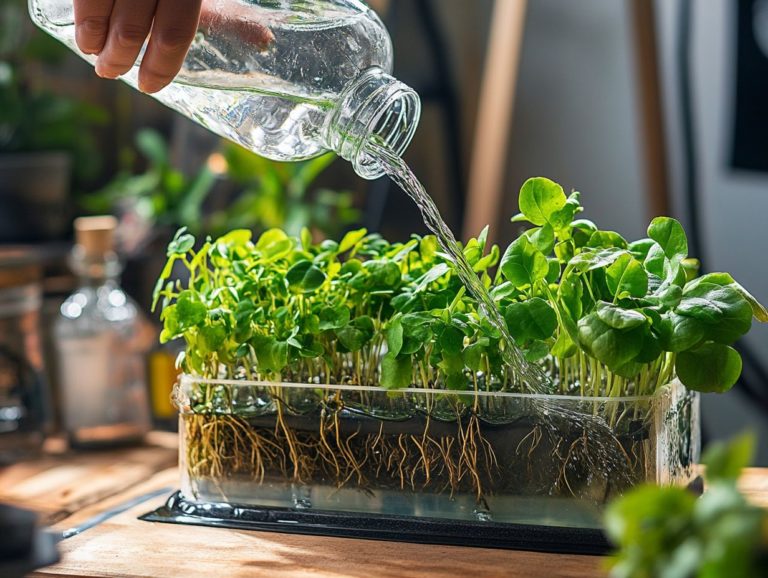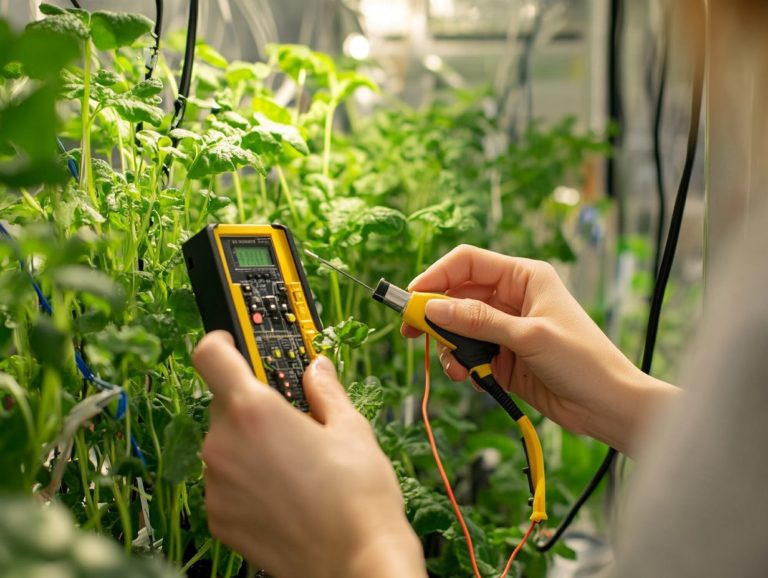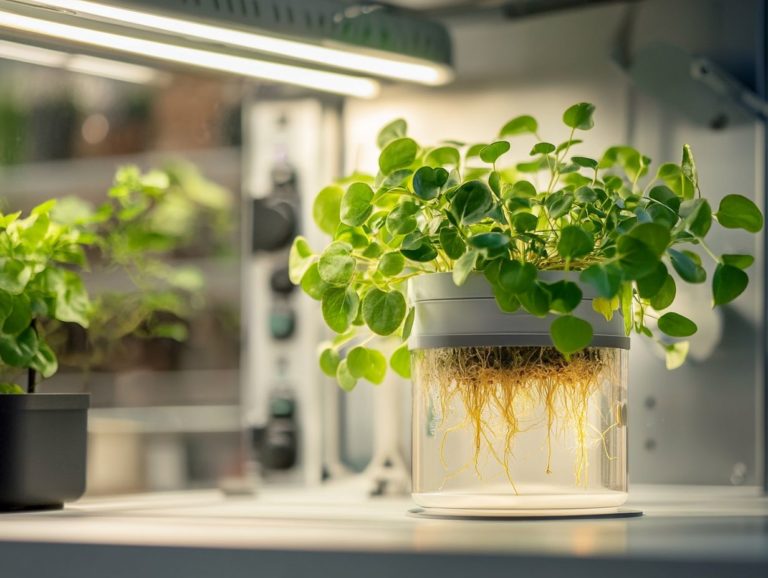5 Ways to Test Hydroponic Water Quality
Maintaining optimal water quality is essential for the success of your hydroponic systems. It s especially important to consider the intricate details of pH levels and nutrient concentrations.
Whether you’re a seasoned grower or just beginning your journey, grasping the nuances of water testing can profoundly influence your plants’ health and yield. This guide will walk you through five fundamental testing methods, including pH testing, measuring electrical conductivity, and assessing dissolved oxygen levels. These methods will ensure your hydroponic setup flourishes.
Delve into the significance of water quality, discover the ideal levels, and learn how to tackle any potential issues, such as nutrient deficiencies and harmful bacteria. Give your plants the best care possible! Let s jump right in and explore how to do it!
Contents
- Key Takeaways:
- 1. Conduct a pH Test
- 2. Measure Electrical Conductivity (EC)
- 3. Test for Total Dissolved Solids (TDS)
- 4. Check for Nutrient Levels
- 5. Monitor for Harmful Bacteria or Contaminants
- Why Is Water Quality Important in Hydroponics?
- What Are the Optimal Water Quality Levels for Hydroponics?
- How Often Should Water Quality Be Tested in a Hydroponic System?
- What Are the Different Methods for Testing Water Quality in Hydroponics?
- What Are the Possible Causes of Poor Water Quality in Hydroponics?
- How Can Water Quality Issues Be Resolved in Hydroponics?
- Frequently Asked Questions
- What are the 5 ways to test hydroponic water quality?
- Why is it important to test hydroponic water quality?
- How often should I test hydroponic water quality?
- What factors can affect hydroponic water quality?
- What do the different test results for hydroponic water quality mean?
- Can I use regular water testing kits for hydroponic water quality testing?
Key Takeaways:
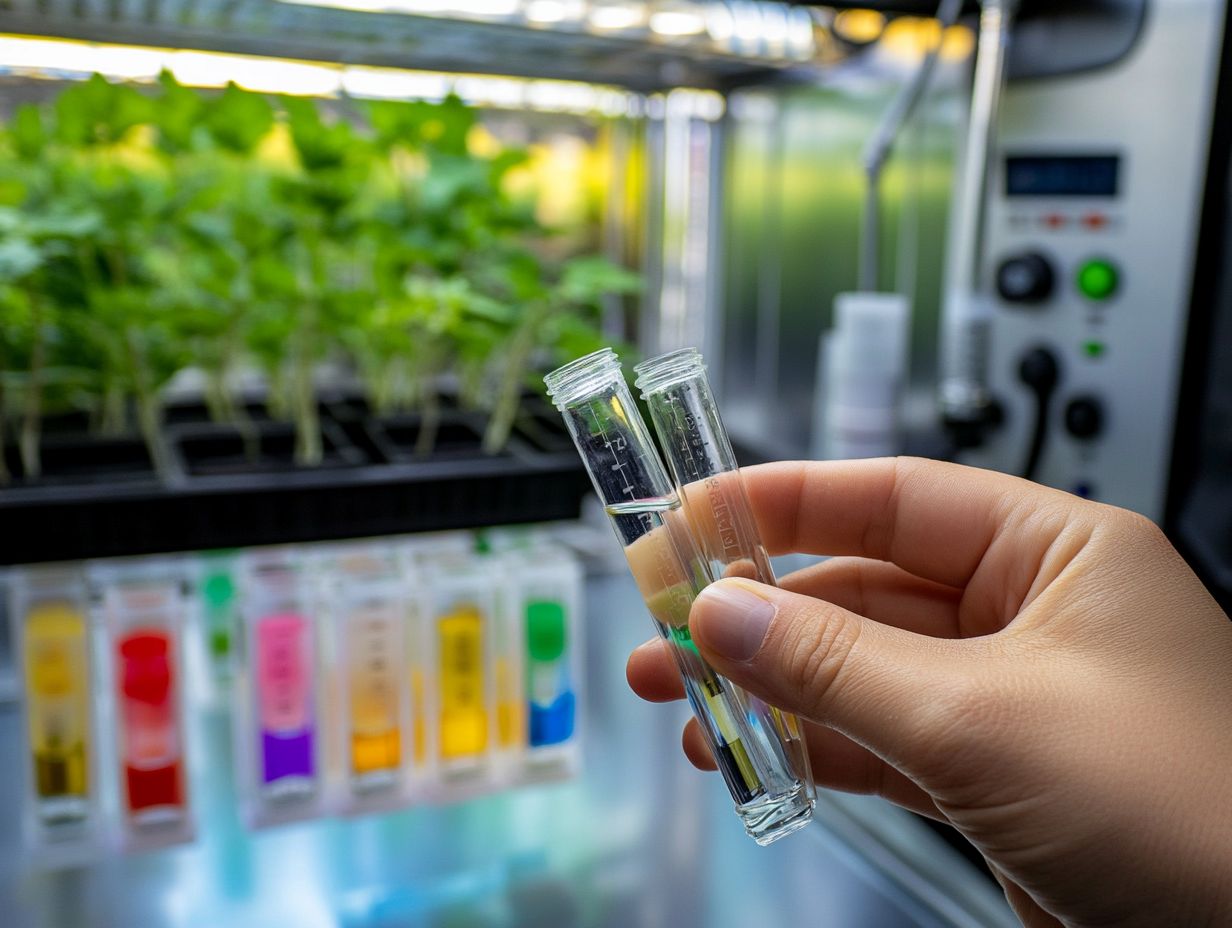
- Maintaining proper pH levels is crucial for healthy hydroponic plants.
- Regularly checking EC, TDS, and dissolved oxygen levels can prevent nutrient imbalances in the water.
- Testing for harmful bacteria and contaminants is essential for plant health and safety.
1. Conduct a pH Test
Conducting a pH test is essential for maintaining a thriving hydroponic system. The pH levels and the nutrient solution ratio greatly influence nutrient uptake, which directly impacts the health and growth of your crops.
By ensuring accurate pH levels within the specific range, you’re creating optimal conditions for plant growth. Regular testing helps you identify nutrient deficiencies and allows you to make necessary adjustments to your nutrient solution, helping your plants grow strong roots.
To perform the test, you can easily use pH testing kits or digital meters. Both options provide precise measurements. The ideal pH range for most hydroponic crops generally falls between 5.5 and 6.5, though some specific plants may need slight tweaks.
Maintaining this balance is crucial, as even minor deviations can impede nutrient availability, leading to stunted growth or unsightly leaf discoloration. For optimal results, check pH levels at least once a week, especially when you alter or refresh your nutrient solutions.
Choose the right pH testing tools today to ensure your crops thrive! By understanding the various types of pH testing equipment available, you can select the best tools for your unique setup, ensuring that your crops flourish to their fullest potential.
2. Measure Electrical Conductivity (EC)
Measuring electrical conductivity tells you how much nutrient is in your water. This measurement is essential in hydroponics, as it helps you optimize your systems for maximum yield.
By keeping an eye on EC levels, you can adjust nutrient concentrations based on the specific needs of your crops. This ensures they receive the right nutrients for healthy growth.
This practice not only enhances nutrient uptake efficiency but also minimizes waste, promoting sustainable practices in your hydroponic farming. Recognizing that different crops have varying optimal EC ranges is crucial for successful cultivation.
For example, leafy greens tend to thrive at lower EC values, while fruiting plants typically require higher concentrations. Monitoring EC using reliable methods, such as a handheld EC meter or inline sensors, gives you real-time data to inform adjustments in your nutrient solutions.
Regularly tweaking these levels based on your readings is vital for maintaining plant health. Fluctuations can hinder nutrient uptake and lead to deficiencies. Be sure to consider your water source and any potential contaminants like chloramines, along with environmental conditions. These factors can significantly impact EC levels and the overall health of your hydroponic system.
3. Test for Total Dissolved Solids (TDS)
Testing for Total Dissolved Solids (TDS) in your hydroponic system is essential for assessing water quality. This measurement helps you make informed decisions about water treatment and nutrient solution balance. It provides valuable insights into the concentration of dissolved substances, including essential nutrients for plant growth.
High TDS levels can be a red flag indicating potential issues with your water treatment or nutrient balance. Prompt action can protect your crops from nutrient deficiencies or toxicities, especially in varying cultivation environments.
Regular TDS monitoring enables you to allocate resources effectively, ensuring your hydro-garden remains vibrant and productive. Understanding the ideal TDS values for your crops is crucial, as these levels vary by plant type.
For example, leafy greens typically thrive in TDS ranges of 800-1500 ppm, while fruiting plants often require higher concentrations, usually between 1500-2500 ppm.
Utilizing tools such as handheld digital meters or multi-parameter probes, including automated systems for consistent monitoring, can streamline your testing process. This ensures you gather reliable data.
Correctly interpreting these readings allows you to adjust nutrient solutions, fostering optimal plant health and yield. By systematically managing TDS levels, you can boost crop performance and safeguard against fluctuating water quality.
4. Check for Nutrient Levels
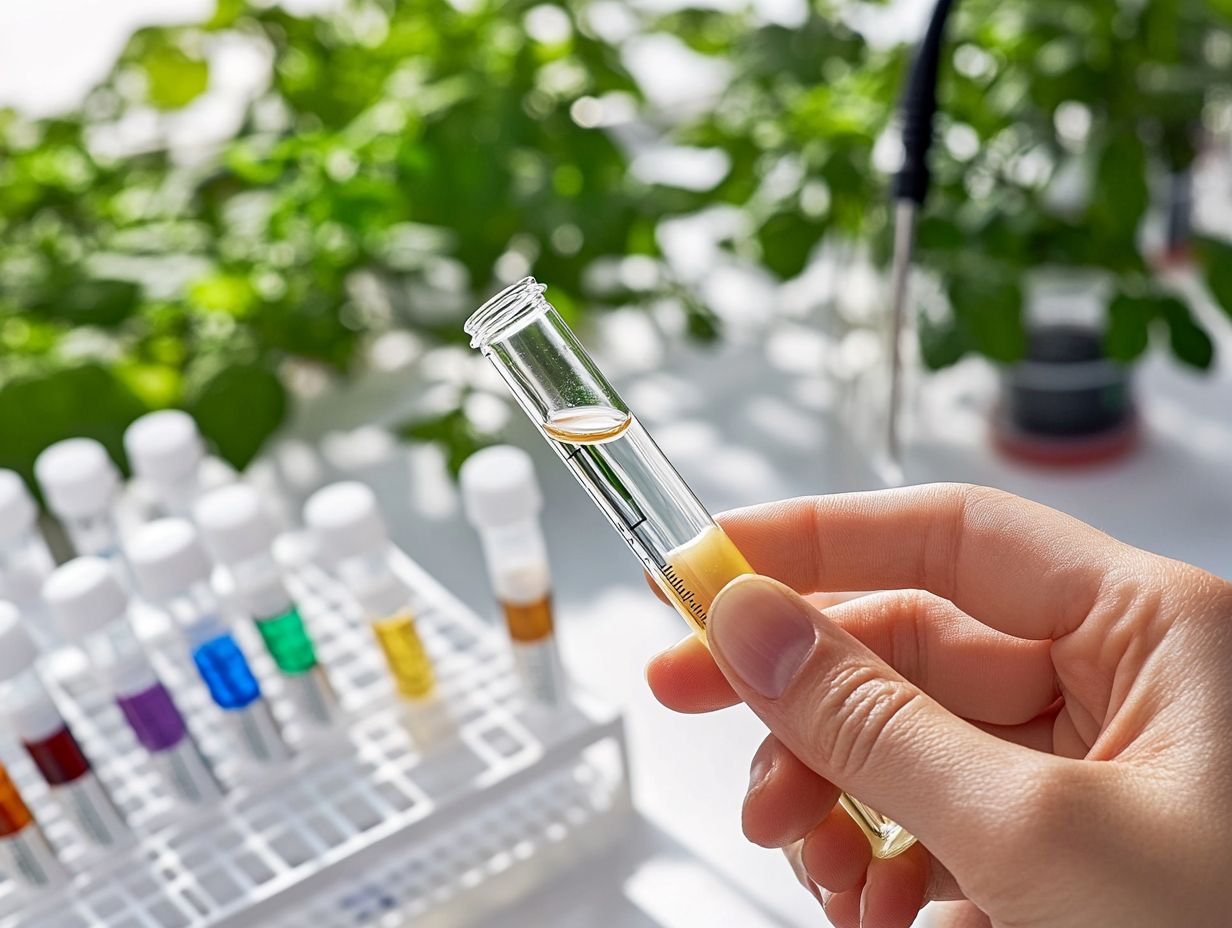
Checking nutrient levels in your hydroponic system is essential for ensuring your plants receive the precise nutrients necessary for optimal growth and development. By closely monitoring concentrations and maintaining correct ratios in your nutrient solution, you can effectively address any potential deficiencies.
Regular assessments enable timely adjustments, fostering sustainable practices and ensuring your hydroponic farming is a success.
Understanding the various types of nutrients like nitrogen, phosphorus, and potassium is vital, as each plays a distinct role in plant health. Symptoms of deficiencies, such as yellowing leaves or stunted growth, signal immediate attention is required.
Utilizing straightforward testing methods with pH (potential of hydrogen) and EC (Electrical Conductivity) meters allows you to accurately gauge nutrient levels. Adjusting nutrient ratios based on specific plant needs like boosting calcium for leafy greens or increasing iron for fruiting plants can significantly enhance crop health.
Adopting a tailored nutrient management strategy is key to maximizing productivity in your hydroponic system.
5. Monitor for Harmful Bacteria or Contaminants
Monitoring harmful bacteria such as Pseudomonas and E. coli, along with contaminants in your hydroponic system, is essential for the health of your plants. When pathogens appear, they can dramatically impact crop yield. Regular water testing including monitoring for algae and bacteria is crucial for preventing outbreaks.
Put effective water maintenance strategies into practice to safeguard your hydro-garden from harmful contaminants. Cultivating a thriving environment requires vigilance!
It s vital to recognize that various strains of bacteria, like Pseudomonas and E. coli, along with contaminants such as heavy metals and chemical residues, can infiltrate your system if not managed properly. Utilizing water testing kits to regularly assess pH, electrical conductivity, and microbial presence provides invaluable insights into your system’s health.
To further mitigate risks, establish preventive measures. This includes ensuring proper sanitation practices and introducing beneficial microorganisms to enhance the health of aquatic systems within your hydroponic setup. Integrating organic pesticides into your pest management strategy helps control unwanted pests while minimizing harm to beneficial insects and plants, creating a more harmonious growing environment.
Why Is Water Quality Important in Hydroponics?
Water quality is crucial in hydroponics. It directly affects nutrient uptake, plant health, and overall system efficiency in various cultivation methods and environments.
For growers dedicated to sustainable practices and environmental responsibility, including the use of organic pesticides, water quality becomes a focal point. Unlike traditional soil gardens, where the soil can buffer nutrient levels, your hydroponic system relies on precise water quality management to deliver essential nutrients to your plants.
If water quality falters, you risk nutrient deficiencies, unhealthy root systems, and a heightened susceptibility to diseases. These issues can negatively influence the environmental footprint of your hydroponic farming.
To maintain optimal water quality, you ll need to monitor various factors like pH levels, electrical conductivity (a measure of nutrient concentration), dissolved oxygen, and total dissolved solids (TDS). Each of these elements, along with water circulation and temperature, is pivotal:
- pH affects nutrient availability,
- EC measures the concentration of nutrients in the solution,
- TDS indicates the overall quality of water.
Neglecting these parameters hinders nutrient absorption, stunting growth and reducing yields. Ultimately, this impacts the environmental footprint of your hydroponic farming.
Therefore, routine water maintenance practices such as filtration, monitoring for pH and EC, and regular testing not only boost plant vitality but also promote a resilient and productive hydroponic environment.
What Are the Optimal Water Quality Levels for Hydroponics?
Optimal water quality levels in hydroponics are essential for maximizing plant growth and ensuring efficient nutrient uptake. This requires precise management of parameters like pH and electrical conductivity.
While the specific pH range and EC levels can vary by crop, understanding these optimal conditions enables you to tailor your nutrient solutions effectively. For example, leafy greens thrive in a slightly acidic environment with a pH of around 5.5 to 6.5, whereas fruiting crops like tomatoes and peppers prefer a pH range of 5.8 to 6.2.
It s also essential to monitor electrical conductivity (EC), aiming for levels between 1.2 and 2.0 mS/cm, which are generally ideal for many crops.
To uphold these optimal conditions, regular testing with reliable meters is crucial. Adjustments can be made using pH Up or Down solutions and concentrated nutrient mixes. If deviations arise, like the pH dropping too low or the EC exceeding the target range, corrective actions such as diluting with pure water or recalibrating the nutrient ratio will help restore balance. For more detailed guidance, refer to this resource on how to test your hydroponic nutrient solution. This ensures your plants receive the essential nutrients they need for optimal growth.
How Often Should Water Quality Be Tested in a Hydroponic System?
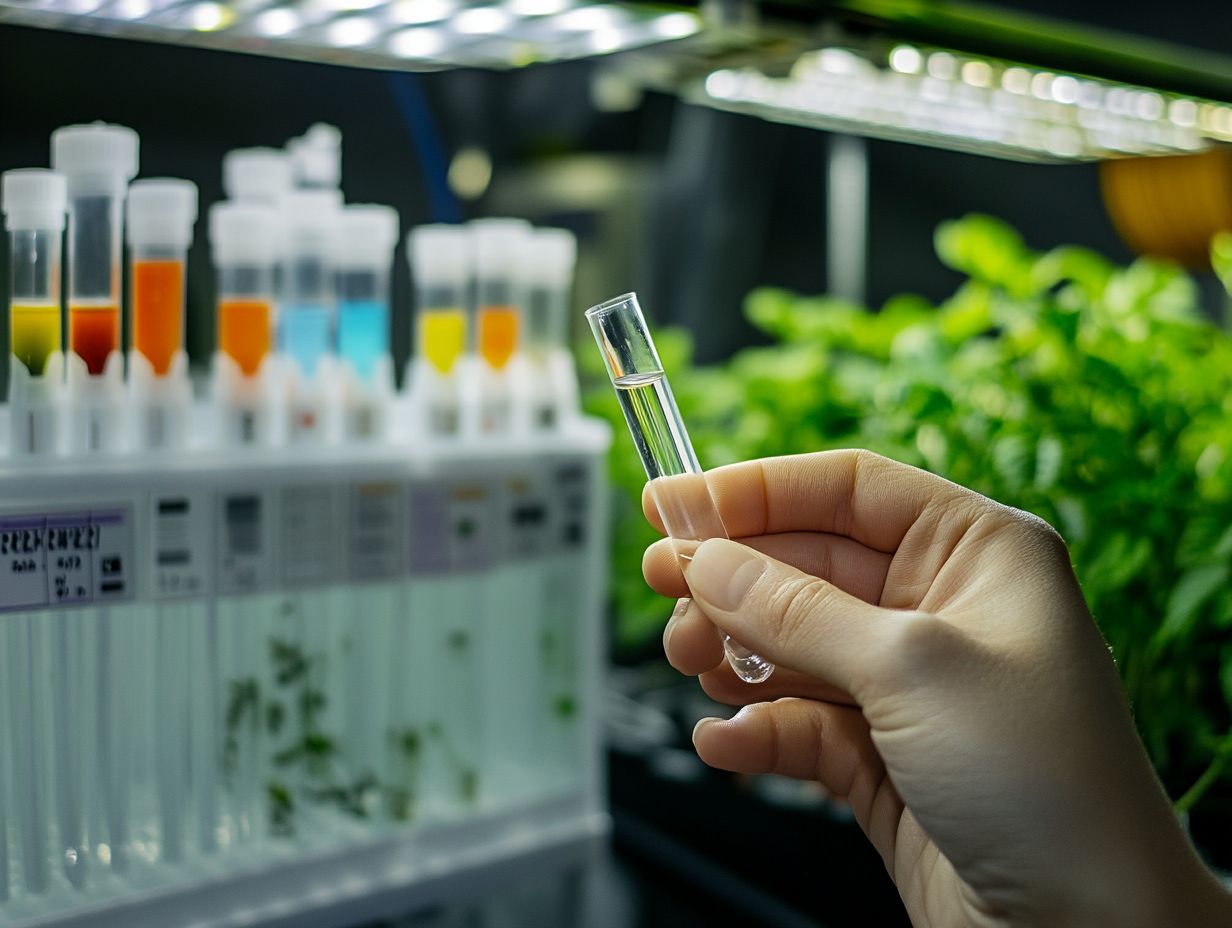
Establishing a regular testing frequency for water quality in your hydroponic system is essential for ensuring that all parameters such as pH, electrical conductivity, and nutrient levels remain within optimal ranges for healthy plant growth.
Frequent testing allows you to detect fluctuations early, enabling timely adjustments to your nutrient solution and water maintenance practices. While the recommended frequency may vary based on your specific cultivation methods and environmental conditions, consistency is key to a thriving hydro-garden. For more guidance, refer to the steps for effective hydroponic troubleshooting.
If you’re just starting out, test daily during the early stages of crop growth. Seedlings are particularly sensitive to water quality. As your plants mature, you could scale back to weekly testing, but stay vigilant during significant environmental changes like rising temperatures or humidity levels that could affect nutrient uptake. For more detailed guidance, check out this article on how to test nutrient levels in hydroponics.
Certain crops, especially those with high nutrient demands, may require more frequent assessments to ensure they thrive. By tailoring your testing schedule to meet specific needs, you can maintain a stable environment that promotes vigorous growth and minimizes potential setbacks.
Don t wait! Regularly check your water quality to ensure thriving plants and to optimize your hydroponic experience.
What Are the Different Methods for Testing Water Quality in Hydroponics?
There are various methods for testing water quality in hydroponics. Each method offers unique insights into essential parameters that influence plant health and system performance.
By using suitable testing equipment like pH meters, EC meters, and TDS meters, you can monitor the health of your hydroponic system. Choosing the right method for water quality testing is vital for timely interventions and for learning how to troubleshoot common hydroponic issues to ensure crop success.
Every method has its own set of advantages and disadvantages. For example, pH meters are critical for assessing the acidity of your nutrient solution, which directly affects nutrient availability. However, they require regular calibration to maintain accuracy.
On the other hand, EC meters</b measure nutrient levels, while TDS meters assess overall salinity. Using both together provides a complete picture of nutrient health.
When selecting testing equipment, consider the specific needs of your hydroponic system, such as scale, budget, and the crucial parameters for your crop. By understanding what each method measures, you can tailor your monitoring practices to create optimal conditions for plant growth. For detailed insights, explore how to conduct hydroponic nutrient experiments.
What Are the Possible Causes of Poor Water Quality in Hydroponics?
Poor water quality in hydroponics can stem from various factors, including contaminants, improper water treatment, and inadequate monitoring practices. These issues can jeopardize nutrient levels and plant health.
To ensure your hydroponic crops thrive, it’s crucial to identify the root causes of water quality issues. Problems like harmful bacteria, excessive chlorine or chloramines, and insufficient dissolved oxygen can significantly hinder growth and yield. Understanding how to test water quality for nutrient absorption can help mitigate these issues.
Environmental factors, such as temperature fluctuations and high humidity, can worsen water quality, creating ideal conditions for pathogens. Missteps like an improper pH balance and poor nutrient solution management also contribute greatly to these challenges.
Regularly monitor water quality parameters using reliable testing kits to tackle these issues. Implement effective water treatment systems, like sediment filters or ultraviolet sterilizers, to neutralize contaminants efficiently.
By taking a proactive approach focused on monitoring and treatment, you can enhance the resilience of your hydroponic systems and ensure sustainable growth.
How Can Water Quality Issues Be Resolved in Hydroponics?
Resolving water quality issues in hydroponics requires a proactive mindset. Regular monitoring, effective maintenance, and swift corrective actions are essential for cultivating a thriving growing environment.
Optimize water treatment processes and use organic pesticides when necessary. Ensure proper water circulation to significantly enhance water quality.
Beyond immediate fixes, embrace routine maintenance. Regularly clean filters, test pH levels, and check nutrient concentrations. This practice is crucial for long-term vitality.
Integrating advanced water filtration systems and consistently balancing nutrients helps prevent potential toxicity in your plants.
Taking preventative measures, such as implementing rainwater collection systems, ensures that only high-quality water enters your system. These efforts lead to healthier crops and promote an eco-friendly approach that benefits both the ecosystem and the economic viability of hydroponic farming.
Ready to enhance your hydroponic system? Start implementing these strategies today for a thriving garden!
Frequently Asked Questions
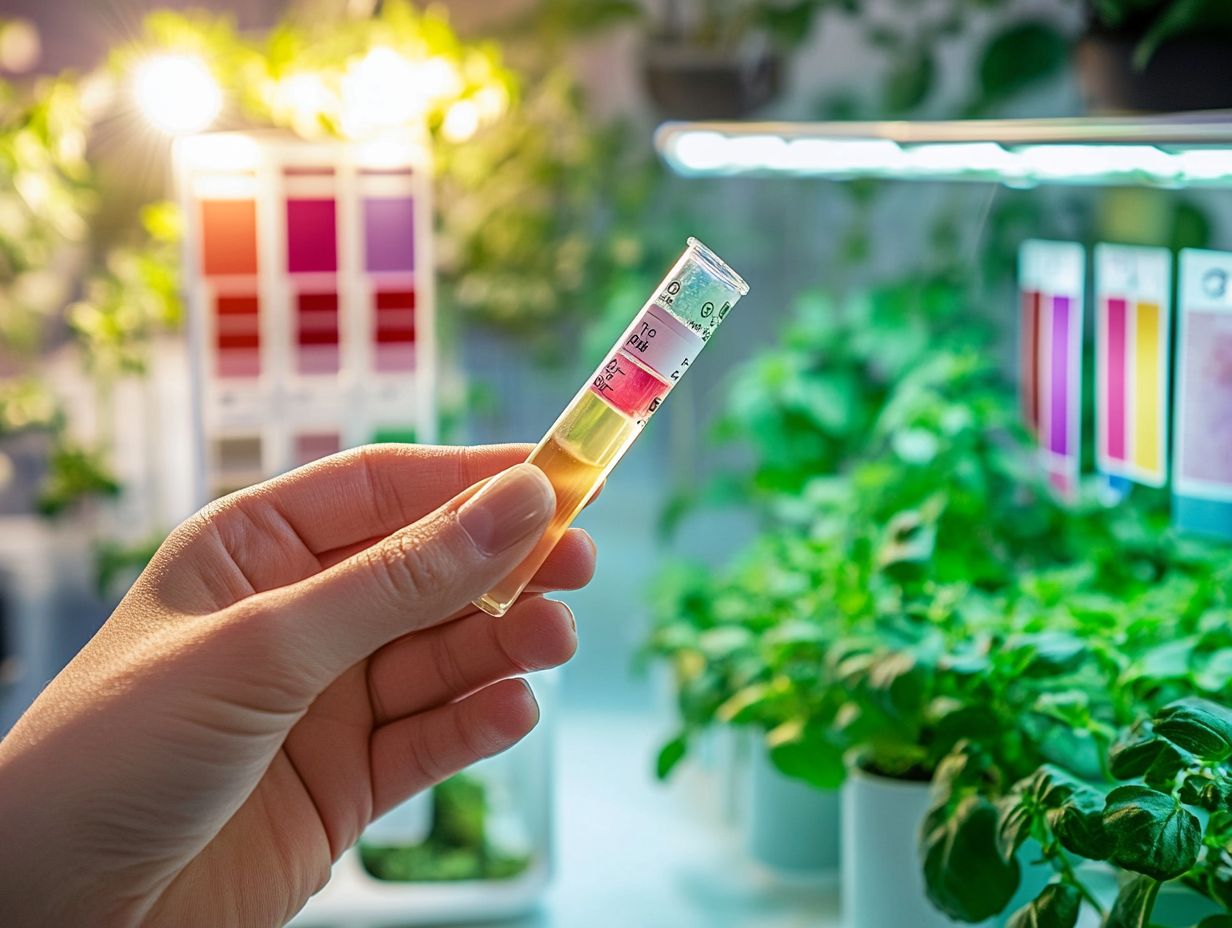
What are the 5 ways to test hydroponic water quality?
The 5 ways to test hydroponic water quality are: electrical conductivity (EC) testing, pH testing, dissolved oxygen testing, total dissolved solids (TDS) testing, and nutrient testing to maintain balance in your hydroponic system.
Why is it important to test hydroponic water quality?
Testing hydroponic water quality is crucial. It ensures the water is suitable for plant growth and provides essential nutrients.
How often should I test hydroponic water quality?
Check your hydroponic water quality at least once a week. This keeps water conditions consistent and optimal for your plants.
What factors can affect hydroponic water quality?
Several factors can impact hydroponic water quality, including temperature, pH levels, nutrient levels, and dissolved oxygen levels.
What do the different test results for hydroponic water quality mean?
Test results can reveal if your water is too acidic or basic. They help you understand nutrient levels and whether adjustments are needed.
Can I use regular water testing kits for hydroponic water quality testing?
Some basic kits may work, but specialized kits are best. They provide accurate results tailored for hydroponic systems.


